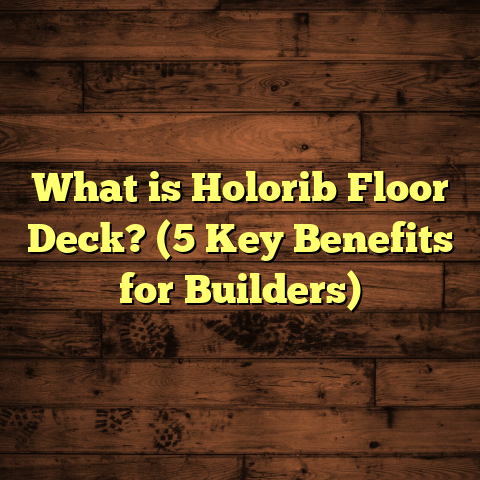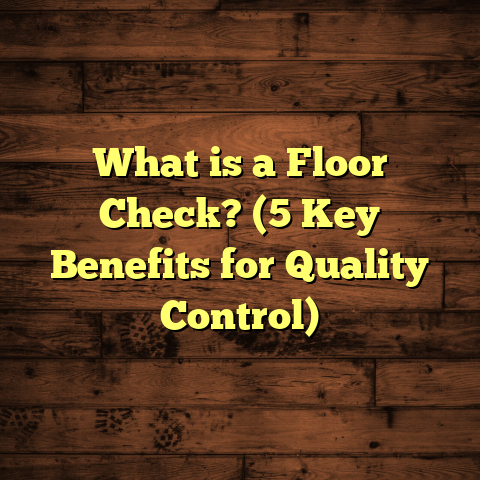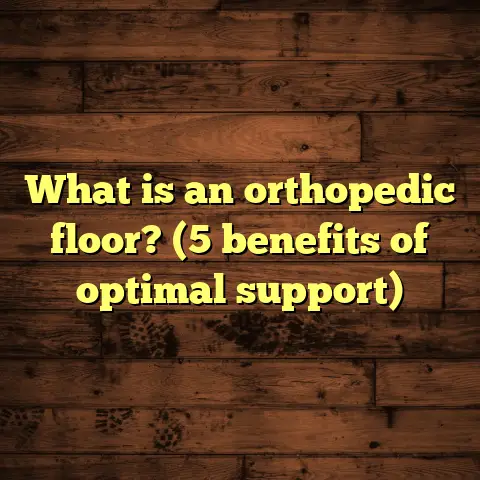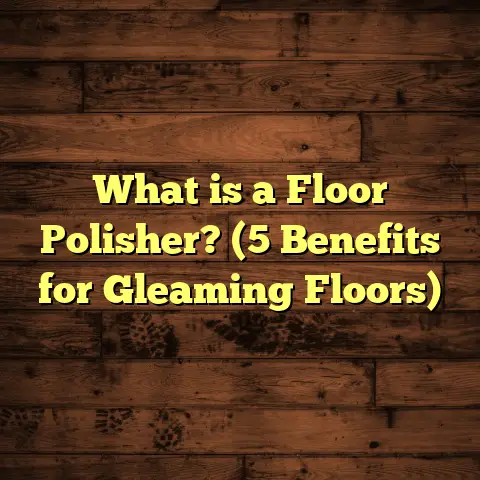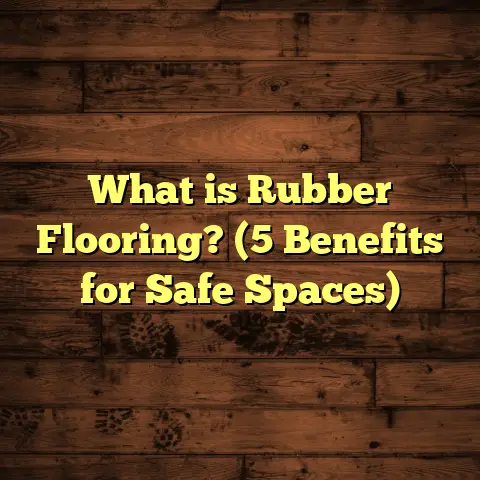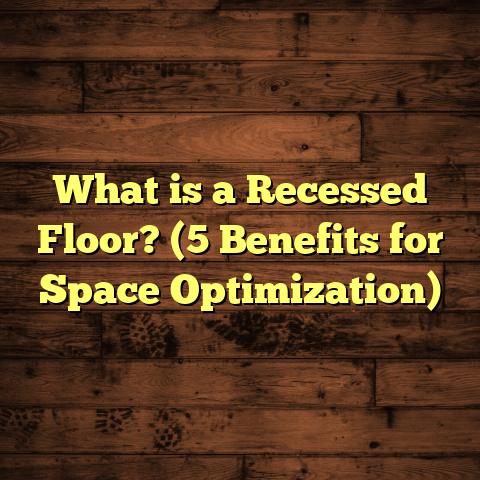What is LVT Flooring? (5 Key Benefits You Should Know)
When I first started working with different flooring types, one thing that always caught my attention was how easy some floors were to care for compared to others. LVT flooring quickly stood out because of its low maintenance and durability. If you’re like me and hate spending weekends scrubbing floors or dealing with constant repairs, LVT might be something you want to explore.
Over the years, I’ve installed LVT in a variety of homes and businesses, and I’ve learned a lot about why this material is gaining so much popularity. So, let me take you through what makes LVT flooring a top choice for many people, including some personal stories, tips from my experience, and important data to back it all up.
What is LVT Flooring?
LVT stands for Luxury Vinyl Tile. It’s a type of resilient flooring that looks like natural materials such as wood, stone, or ceramic but is made from several layers of vinyl. This layered construction makes it both flexible and tough, combining beauty with practicality.
Unlike traditional vinyl sheets you might be picturing, LVT comes in individual tiles or planks. This allows for easy installation and customization. The top layer has a detailed printed design covered by a transparent wear layer that protects against scratches and stains. Beneath this is a core layer that gives stability and support.
I’ve noticed many homeowners confused LVT with laminate or vinyl sheet flooring. The difference? Laminate usually has a fiberboard core and isn’t waterproof, while LVT is water-resistant or even fully waterproof, making it ideal for kitchens, bathrooms, and basements.
A Closer Look at LVT Construction
Let’s break down the layers to understand why LVT performs so well:
- Wear Layer: This transparent layer is what protects your floor from scratches, stains, and dents. The thickness of this layer can range from 6 mils (thousandths of an inch) in residential products to 28 mils or more in commercial-grade flooring.
- Design Layer: Using advanced printing technology, this layer replicates natural materials with stunning realism. Whether you want the grain of oak or the look of polished marble, this layer delivers.
- Core Layer: This is usually made of vinyl or PVC and provides the floor’s structure. Some cores are rigid for extra durability (Rigid Core LVT), while others are more flexible.
- Backing Layer: The bottom layer stabilizes the tile or plank and sometimes includes soundproofing materials.
How LVT Stands Out Compared to Other Flooring Types
You might wonder how LVT compares to options like hardwood, laminate, or ceramic tile. From my experience:
- Compared to Hardwood: LVT is much more resistant to moisture and scratches. Hardwood can warp or stain if exposed to water, but LVT won’t.
- Compared to Laminate: Laminate is not waterproof and can swell when wet. Plus, laminate’s surface can chip more easily.
- Compared to Ceramic Tile: Tile is durable but cold and hard underfoot. LVT feels warmer and softer while still being tough.
- Compared to Sheet Vinyl: LVT offers better aesthetics because of its tile/plank format and realistic textures.
5 Key Benefits You Should Know About LVT Flooring
I want to share five benefits that really make LVT stand out based on my projects and client feedback.
1. Easy to Clean and Maintain
One of the reasons I recommend LVT so often is because it’s incredibly easy to keep clean. Sweeping or vacuuming regularly and occasional mopping with mild soap is enough to keep it looking fresh. No need for special cleaners or wax treatments like hardwood requires.
From my experience, this ease of care is a huge relief for families with kids or pets. Spills wipe up quickly without staining, which is a life-saver during busy mornings or parties.
I remember working with a family who had three young kids and an energetic golden retriever. Their hardwood floors were always scratched and stained until we installed LVT in their kitchen and living area. They told me it was the best decision because cleaning was now a breeze—even when juice spilled or muddy paws tracked dirt inside.
Cleaning Tips That Work Best
- Use a broom or vacuum with a soft brush attachment regularly.
- Mop with warm water mixed with a few drops of dish soap.
- Avoid abrasive scrubbers or harsh chemicals.
- Wipe spills immediately to prevent sticky residues.
2. Durability That Holds Up Over Time
LVT is designed to withstand heavy foot traffic. The wear layer on top protects against scratches, dents, and scuffs better than most other flooring options in its price range.
I once did a case study on an office space that installed LVT five years ago. Even after daily use by dozens of employees, the floor showed minimal signs of wear. That kind of performance is hard to find without spending a fortune on materials like natural stone.
Another project involved a retail store where rolling carts and heavy footfall would usually damage floors quickly. The store owner was amazed at how well the floor maintained its appearance after two years.
What Makes LVT So Durable?
The wear layers vary in thickness depending on the product grade:
- Residential wear layers usually range between 6 mils to 12 mils.
- Commercial-grade wear layers go up to 28 mils for maximum protection.
The thicker this layer, the longer your floor will last without visible damage.
3. Waterproof Qualities
One thing that surprises many people is just how well LVT handles water exposure. Unlike hardwood or laminate, which can warp or swell when wet, LVT stays intact because of its vinyl composition.
I’ve installed it in bathrooms and laundry rooms where moisture is a constant threat, and clients never complain about water damage. Plus, the seams between tiles are tight enough to prevent water from seeping underneath easily.
A recent project was in a basement converted into a family room with occasional flooding issues during heavy rains. Instead of worrying about floor damage every time it flooded, the homeowner was able to dry the floor quickly without any lasting harm.
Waterproof vs Water-Resistant — What’s the Difference?
- Waterproof: Completely impervious to water; no swelling or warping occurs.
- Water-Resistant: Can resist water exposure for some time but might be damaged if soaked continuously.
Most high-quality LVT products fall into the waterproof category.
4. Versatile Design Options
If you want floors that look like real wood, stone, or tile without the cost or hassle, LVT delivers on style. The printed design layer uses high-definition imaging technology to replicate natural textures convincingly.
I often tell clients that with LVT, you don’t have to sacrifice style for practicality. From rustic oak planks to sleek marble patterns, there’s something for every taste.
One memorable project was for a client who wanted the appearance of reclaimed barn wood floors but needed something kid-proof and moisture-resistant for their open-plan kitchen/dining room. We found an LVT product with textured grain and color variation that even fooled hardwood enthusiasts.
Design Trends I’ve Seen Gain Popularity
- Wide plank formats for modern farmhouse looks.
- Herringbone patterns using rectangular tiles.
- Stone-look tiles mimicking travertine or slate.
- Mixed media designs combining wood-look planks with patterned tiles in entryways.
5. Budget-Friendly Without Sacrificing Quality
Cost is always a big factor for me and many homeowners I’ve worked with. LVT offers a great balance between affordability and quality.
According to recent industry data, LVT averages around $2 to $7 per square foot for materials alone. When you factor in professional installation, you’re still looking at a much lower cost than hardwood or natural stone.
When I plan flooring projects, I use FloorTally to get accurate cost estimates based on local prices for materials and labor. It helps me budget realistically and avoid surprises during installation. This tool also lets me factor in waste and visualize total costs quickly.
For example, on one kitchen remodel project measuring 300 square feet:
- Material cost estimate from FloorTally: $900 – $2100 (depending on product chosen)
- Installation estimate: $600 – $1200 This gave my clients confidence in their budget before we started work.
Deeper into My Experience With LVT Flooring
Installing LVT: What I’ve Learned Over Time
Installation makes a big difference in how well your floor performs long term. I’ve installed hundreds of square feet of LVT by now and here are some lessons I’ve learned:
- Preparation is everything: Make sure the subfloor is clean, level, dry, and free from debris.
- Use spacers if floating: For click-lock systems, leave proper expansion gaps around edges.
- Glue-down needs precision: If gluing down tiles/planks, spread adhesive evenly without lumps.
- Acclimate materials: Let the boxes sit in the installation room for 48 hours so they adjust to temperature/humidity.
One client once tried DIY installation but didn’t prepare their concrete slab properly—it was uneven with bumps causing some tiles to crack later on. After fixing the subfloor professionally, we re-installed the flooring correctly without issues.
Tips For Longevity From My Toolkit
To help your floor last as long as possible:
- Use felt pads under furniture legs.
- Avoid dragging heavy objects across the floor.
- Clean spills promptly.
- Use doormats at entries to reduce dirt tracked inside.
Sound Absorption: A Bonus Many Don’t Expect
LVT can sometimes feel hollow or loud when walked on without underlayment. In several projects where sound control was important (condos or apartments), adding an acoustic underlayment beneath installed planks made a huge difference in reducing footsteps noise.
Real-Life Case Studies I’ve Been Part Of
Case Study 1: Family Home Kitchen Renovation
A family with two kids wanted new flooring that could handle everything from spilled milk to muddy boots. We chose an oak-look LVT with a 12 mil wear layer installed as click-lock floating floor over an underlayment.
After two years:
- No visible scratches despite heavy use.
- Easy cleanup saved time every day.
- Moisture resistance protected against occasional spills.
The parents told me they were thrilled not having to worry about ruining expensive hardwood floors anymore.
Case Study 2: Commercial Office Space Flooring Upgrade
A mid-sized law firm needed durable yet attractive floors that would survive high foot traffic from clients and staff but still look professional.
We selected commercial-grade LVT with gluedown installation:
- Wear layer of 28 mils for scratch resistance.
- Neutral stone pattern matching office decor.
Five years later:
- Minimal wear reported.
- Client saved thousands by avoiding carpet replacement cycles.
They complimented me on how easy it was to maintain compared to their old carpet tiles that trapped dust and odors.
Data That Supports Why I Trust LVT Flooring
Here are some statistics that back up what I’ve seen professionally:
- The global luxury vinyl tile market has grown steadily by about 6% annually over the last decade (Freedonia Group).
- Consumer surveys show over 70% satisfaction rate among homeowners who chose LVT for durability and style (Floor & Decor).
- Laboratory tests reveal that quality LVT resists scratching from metal chair legs better than engineered wood (Home Flooring Research Lab).
These figures align closely with my hands-on feedback from customers who rave about how their floors look even after years of use.
Frequently Asked Questions About LVT Flooring — My Answers
Q: How long does LVT flooring typically last?
A: With proper care and good installation, residential-grade LVT can last 10-20 years or more. Commercial-grade can last even longer depending on traffic levels.
Q: Can I install LVT over existing flooring?
A: Often yes—if the existing floor is flat and stable (like vinyl sheet or tile). You’ll want to avoid installing over carpeting or uneven surfaces.
Q: Is LVT comfortable underfoot?
A: It’s softer than ceramic tile but firmer than carpet padding. Adding underlayment improves comfort significantly.
Q: Does sunlight fade LVT colors?
A: High-quality products have UV protection in the wear layer; however prolonged direct sunlight exposure may cause some fading over time.
Wrapping Up My Thoughts
If you want something practical, stylish, and budget-friendly that won’t bog you down with maintenance chores, LVT flooring deserves serious thought. I’ve seen it work wonders in homes and commercial spaces alike.
Have you tried LVT before? What was your experience? Or maybe you’re thinking about making the switch but want more advice? Feel free to ask—I’m here to help!
